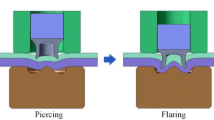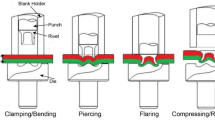Abstract
Self-piercing riveting (SPR) is one of the major joining processes in the automotive industry. However, the frequently used design method for multiple SPR joints is still time-consuming, and relies heavily on engineers’ experience and experimental SPR tests. This research focuses on simplifying the joint design process and improving the design robustness for multiple SPR joints. A fast joint quality prediction model was firstly developed using the deep neural network (DNN), and verified through experimental SPR tests. Then, a joint robustness evaluation strategy was proposed by combining the developed DNN with the Monte Carlo method to consider the manufacturing tolerances of rivet, sheets, and die. Afterwards, two novel approaches were developed to quickly identify the suitable joint design with minimum rivet/die combinations for multiple sheet combinations. The first approach realizes automatic design of robust joints with the DNN model, the robustness evaluation method, and a proposed automatic selection algorithm. The second approach was developed based on application range maps of potential rivet/die combinations, and can be used to quickly identify the suitable joint design for multiple sheet combinations. Finally, experimental SPR tests were conducted to validate the effectiveness of the two joint design methods. Results from this study are helpful to simplify the design process, shorten the design cycle, and improve the robustness of multiple SPR joints.































Similar content being viewed by others
References
Mori K, Abe Y, Kato T (2014) Self-pierce riveting of multiple steel and aluminium alloy sheets. J Mater Process Technol 214:2002–2008. https://doi.org/10.1016/j.jmatprotec.2013.09.007
Karim MA, Jeong TE, Noh W et al (2020) Joint quality of self-piercing riveting (SPR) and mechanical behavior under the frictional effect of various rivet coatings. J Manuf Process 58:466–477. https://doi.org/10.1016/j.jmapro.2020.08.038
Haque R (2018) Quality of self-piercing riveting (SPR) joints from cross-sectional perspective: a review. Arch Civ Mech Eng 18:83–93. https://doi.org/10.1016/j.acme.2017.06.003
Li D, Chrysanthou A, Patel I, Williams G (2017) Self-piercing riveting-a review. Int J Adv Manuf Technol 92:1777–1824. https://doi.org/10.1007/s00170-017-0156-x
Yang B, Ma Y, Shan H et al (2021) Friction self-piercing riveting (F-SPR) of aluminum alloy to magnesium alloy using a flat die. J Magnes Alloy. https://doi.org/10.1016/J.JMA.2020.12.016
Lou M, Li Y, Li Y, Chen G (2013) Behavior and quality evaluation of electroplastic self-piercing riveting of aluminum alloy and advanced high strength steel. J Manuf Sci Eng Trans ASME. https://doi.org/10.1115/1.4023256
Durandet Y, Deam R, Beer A et al (2010) Laser assisted self-pierce riveting of AZ31 magnesium alloy strips. Mater Des 31:S13–S16. https://doi.org/10.1016/j.matdes.2009.10.038
Ma Y, Lou M, Li Y, Lin Z (2018) Effect of rivet and die on self-piercing rivetability of AA6061-T6 and mild steel CR4 of different gauges. J Mater Process Technol 251:282–294. https://doi.org/10.1016/J.JMATPROTEC.2017.08.020
Zhao H, Han L, Liu Y, Liu X (2021) Modelling and interaction analysis of the self-pierce riveting process using regression analysis and FEA. Int J Adv Manuf Technol 113:159–176. https://doi.org/10.1007/s00170-020-06519-9
Deng JH, Lyu F, Chen RM, Fan ZS (2019) Influence of die geometry on self-piercing riveting of aluminum alloy AA6061-T6 to mild steel SPFC340 sheets. Adv Manuf. https://doi.org/10.1007/s40436-019-00250-9
Liu Y, Li H, Zhao H, Liu X (2019) Effects of the die parameters on the self-piercing riveting process. Int J Adv Manuf Technol 105:3353–3368. https://doi.org/10.1007/s00170-019-04567-4
Hoang N-H, Porcaro R, Langseth M, Hanssen A-G (2010) Self-piercing riveting connections using aluminium rivets. Int J Solids Struct 47:427–439. https://doi.org/10.1016/j.ijsolstr.2009.10.009
Uhe B, Kuball CM, Merklein M, Meschut G (2020) Improvement of a rivet geometry for the self-piercing riveting of high-strength steel and multi-material joints. Prod Eng 14:417–423. https://doi.org/10.1007/s11740-020-00973-w
Kraus C, Falk T, Mauermann R, Drossel W-G (2020) Development of a New Self-flaring Rivet Geometry Using Finite Element Method and Design of Experiments. Procedia Manuf 47:383–388. https://doi.org/10.1016/J.PROMFG.2020.04.295
Mucha J (2011) A study of quality parameters and behaviour of self-piercing riveted aluminium sheets with different joining conditions. Stroj Vestnik/Journal Mech Eng 57:323–333. https://doi.org/10.5545/sv-jme.2009.043
Carandente M, Dashwood RJ, Masters IG, Han L (2016) Improvements in numerical simulation of the SPR process using a thermo-mechanical finite element analysis. J Mater Process Technol 236:148–161. https://doi.org/10.1016/j.jmatprotec.2016.05.001
Atzeni E, Ippolito R, Settineri L (2007) FEM modeling of self-piercing riveted joint. Key Eng Mater 344:655–662. https://doi.org/10.4028/www.scientific.net/KEM.344.655
Zhang YH, Shi BJ, Zhong JB (2020) Multi-parameter joint optimization of self-piercing riveting on aluminum alloy plate. J Phys Conf Ser
Tassler T, Israel M, Goede MF et al (2018) Robust joining point design for semi-tubular self-piercing rivets. Int J Adv Manuf Technol 98:431–440. https://doi.org/10.1007/s00170-018-2238-9
Mylavarapu D, Ganesh Narayanan R, Das M (2019) Temperature prediction during self-pierce riveting of sheets by FEA-ANN hybrid model. Adv Comput Methods Manuf. https://doi.org/10.1007/978-981-32-9072-3_24
Jiang L, Huang L, Wang X et al (2020) A crack detection method for self-piercing riveting button images through machine learning. SAE Tech Pap. https://doi.org/10.4271/2020-01-0221
Zhao H, Han L, Liu Y, Liu X (2021) Quality prediction and rivet/die selection for SPR joints with artificial neural network and genetic algorithm. J Manuf Process 66:574–594. https://doi.org/10.1016/j.jmapro.2021.04.033
Fang Y, Huang L, Zhan Z et al (2020) Effect analysis for the uncertain parameters on self-piercing riveting simulation model using machine learning model. In: SAE Technical Papers
Qin Y, Jiang H, Cong Y et al (2020) Rivet die design and optimization for electromagnetic riveting of aluminium alloy joints. Eng Optim 1(19). https://doi.org/10.1080/0305215X.2020.1751149
Jäckel M, Falk T, Georgi J, Drossel WG (2020) Gathering of process data through numerical simulation for the application of machine learning prognosis algorithms. Procedia Manuf 47:608–614. https://doi.org/10.1016/j.promfg.2020.04.186
Paliwal M, Kumar UA (2009) Neural networks and statistical techniques: a review of applications. Expert Syst Appl 36:2–17. https://doi.org/10.1016/j.eswa.2007.10.005
Katherasan D, Elias JV, Sathiya P, Haq AN (2014) Simulation and parameter optimization of flux cored arc welding using artificial neural network and particle swarm optimization algorithm. J Intell Manuf 25:67–76. https://doi.org/10.1007/s10845-012-0675-0
Lecun Y, Bengio Y, Hinton G (2015) Deep learning. Nature 521:436–444. https://doi.org/10.1038/nature14539
Samek W, Binder A, Montavon G et al (2017) Evaluating the visualization of what a deep neural network has learned. IEEE Trans Neural Networks Learn Syst 28:2660–2673. https://doi.org/10.1109/TNNLS.2016.2599820
Oh S, Kim HK, Jeong TE et al (2020) Deep-learning-based predictive architectures for self-piercing riveting process. IEEE Access 8:116254–116267. https://doi.org/10.1109/ACCESS.2020.3004337
Feng S, Zhou H, Dong H (2019) Using deep neural network with small dataset to predict material defects. Mater Des 162:300–310. https://doi.org/10.1016/j.matdes.2018.11.060
Xie Q, Suvarna M, Li J et al (2021) Online prediction of mechanical properties of hot rolled steel plate using machine learning. Mater Des 197:109201. https://doi.org/10.1016/j.matdes.2020.109201
Olden JD, Joy MK, Death RG (2004) An accurate comparison of methods for quantifying variable importance in artificial neural networks using simulated data. Ecol Modell 178:389–397. https://doi.org/10.1016/j.ecolmodel.2004.03.013
Yang L, Jiang H (2021) Weld defect classification in radiographic images using unified deep neural network with multi-level features. J Intell Manuf 32:459–469. https://doi.org/10.1007/s10845-020-01581-2
Kwon O, Kim HG, Ham MJ et al (2020) A deep neural network for classification of melt-pool images in metal additive manufacturing. J Intell Manuf 31:375–386. https://doi.org/10.1007/s10845-018-1451-6
Cai Y, Zheng W, Zhang X et al (2019) Research on soil moisture prediction model based on deep learning. PLoS ONE 14:1–19. https://doi.org/10.1371/journal.pone.0214508
Bengio Y, Lamblin P, Popovici D, Larochelle H (2007) Greedy layer-wise training of deep networks. Adv Neural Inf Proces Syst pp 153–160
Hinton GE, Salakhutdinov RR (2006) Reducing the dimensionality of data with neural networks. Science 313(80):504–507. https://doi.org/10.1126/science.1127647
Seifi A, Dehghani M, Singh VP (2020) Uncertainty analysis of water quality index (WQI) for groundwater quality evaluation: Application of Monte-Carlo method for weight allocation. Ecol Indic 117:106653. https://doi.org/10.1016/j.ecolind.2020.106653
EN485–4:1993 (1993) Aluminium and aluminium alloys — sheet, strip and plate — Part 4: tolerances on shape and dimensions for cold-rolled products
Acknowledgements
The authors would like to thank Dr. Matthias Wissling, Paul Bartig, and their team members from Tucker GmbH for their supports during the laboratory tests.
Funding
This research is funded by Jaguar Land Rover.
Author information
Authors and Affiliations
Contributions
All authors contributed to the study conception and design. Material preparation, data collection, and analysis were performed by Huan Zhao and Yunpeng Liu. The first draft of the manuscript was written by Huan Zhao, and all authors commented on previous versions of the manuscript. All authors read and approved the final manuscript.
Corresponding author
Ethics declarations
Ethics approval
Not applicable.
Consent to participate
All the authors participated in this research.
Consent for publication
All the authors approved the final manuscript for publication.
Conflict of interest
The authors declare no competing interests.
Additional information
Publisher's Note
Springer Nature remains neutral with regard to jurisdictional claims in published maps and institutional affiliations.
Rights and permissions
Springer Nature or its licensor holds exclusive rights to this article under a publishing agreement with the author(s) or other rightsholder(s); author self-archiving of the accepted manuscript version of this article is solely governed by the terms of such publishing agreement and applicable law.
About this article
Cite this article
Zhao, H., Han, L., Liu, Y. et al. Automatic and robust design for multiple self-piercing riveted joints using deep neural network. Int J Adv Manuf Technol 122, 947–975 (2022). https://doi.org/10.1007/s00170-022-09893-8
Received:
Accepted:
Published:
Issue Date:
DOI: https://doi.org/10.1007/s00170-022-09893-8




